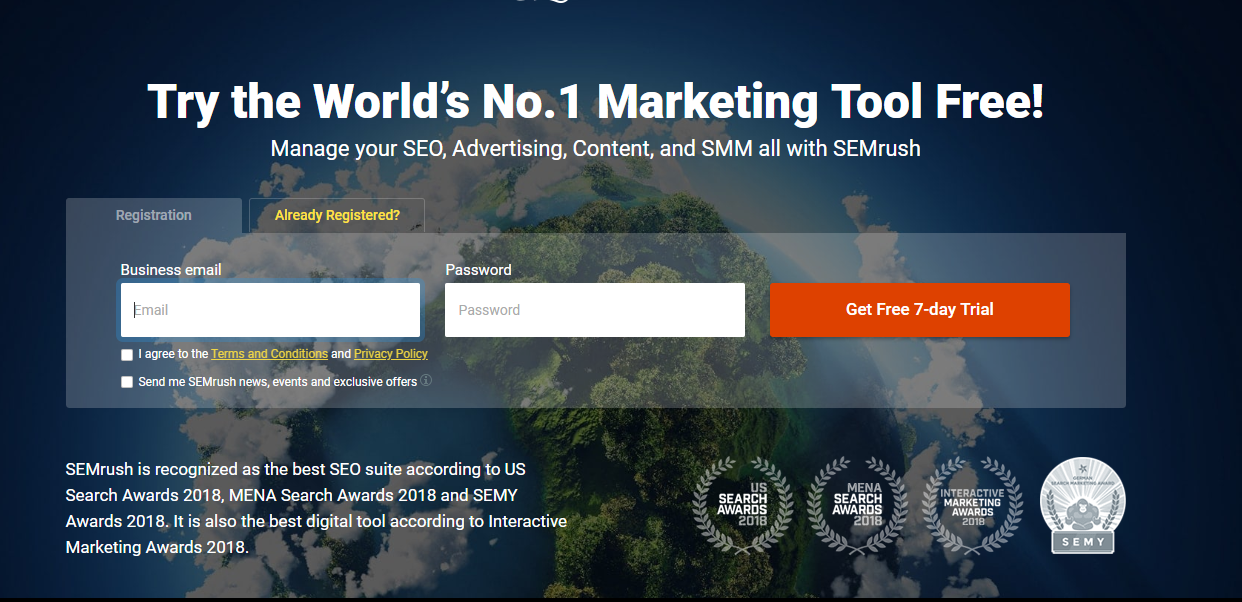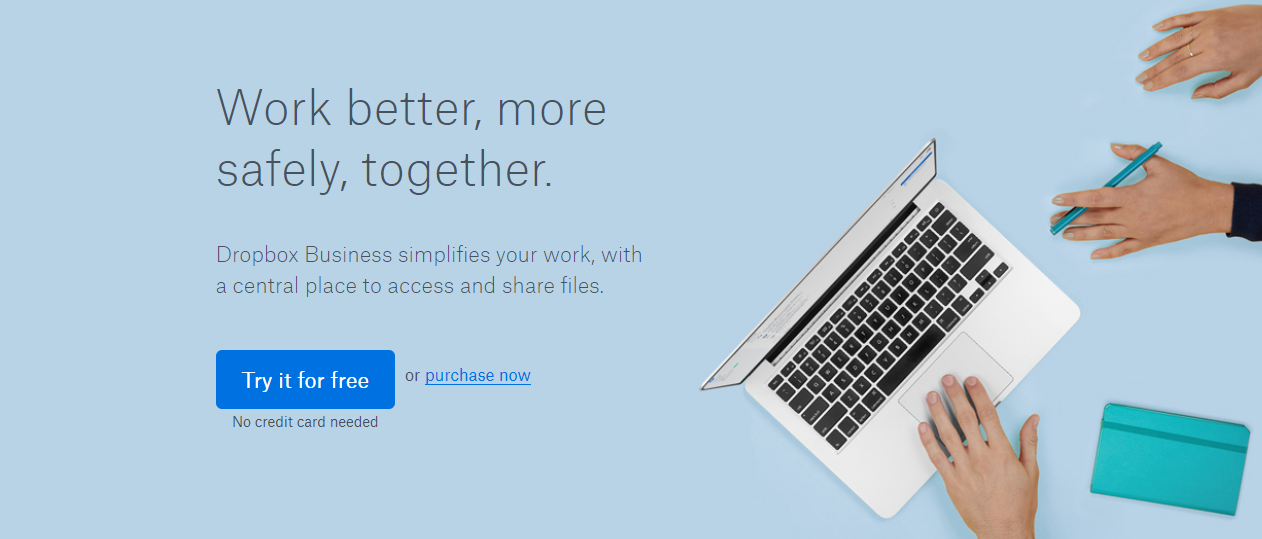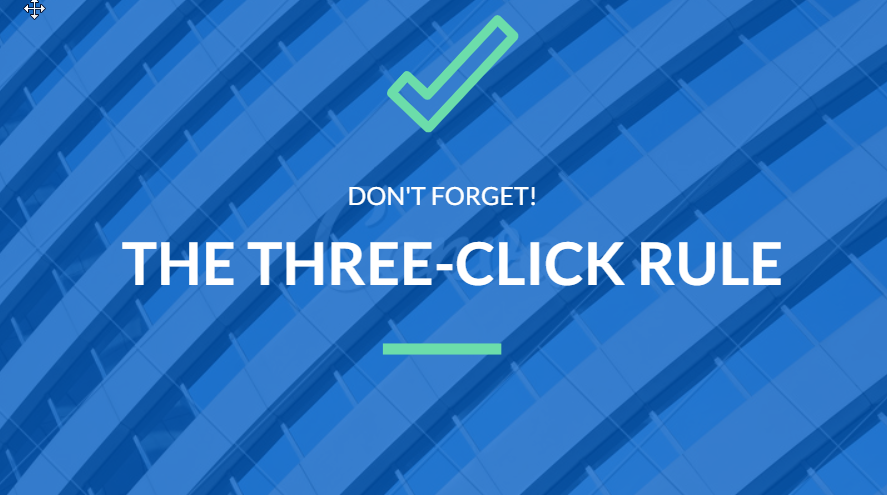The homepage of your website is a crucial digital lobby to showcase your key objectives, unique selling points (USPs) and define how your business can help your website visitor. Sounds simple, right? Given that it takes a visitor only half a second to form an opinion of your website, in fact, the particulars behind making that perfect first impression can so often be overlooked
1. Get to the point
Tell them who you are in the key message above ‘the fold’ (the section of the website that appears before a user has to scroll). Establish a key, strong and punchy message about who you are and how your offering benefits your visitor.
Social media management giant, SEMRush tap into the pain point of their target market whilst describing their tool in two short sentences:

2. Keep it clean
It may be tempting to embellish and adorn your homepage with fancy animation and aesthetic gimmicks, but in truth, the simpler the better when it comes to generating a strong and impactful homepage design. Whilst attention to detail, appropriate imaging and brand loyalty are imperative, maintaining a professional and sleek digital ‘face’ for your business will enable your visitor to focus on your messaging without unnecessary distraction.
Dropbox steer clear of any fancy design elements, and instead opt for a black on white and blue, clear and well laid out homepage:

3. Outline your objectives
Your visitors will know what they want to find out by visiting your homepage, and it’s your job to make sure they can achieve those objectives simply and quickly. Homepages with high bounce rates (number of visitors who leave the homepage without navigating anywhere else) are often bereft of calls to action or clear direction for their visitors. If possible, try and include a call to action in a strong and visible button above the fold. Both Dropbox and SEMRush direct the visitor to perform either one, or one of two very clear actions before they even hit the scroll button.
4. Make it responsive
The digital landscape has seen a shift to mobile-centric and cross-device browsing, and in 2017, over half of all website visits globally were from a mobile phone. (Source: Statista – https://www.statista.com/statistics/241462/global-mobile-phone-website-traffic-share/)
 With numbers set to climb further, websites that do not perform on mobile, generally have a high bounce rate, a low retention rate and a bleak future.
With numbers set to climb further, websites that do not perform on mobile, generally have a high bounce rate, a low retention rate and a bleak future.
5. Make it quick
With studies suggesting over 50% of mobile users abandon websites that take longer than 3 seconds to load, maintaining a low page load speed is imperative in ensuring you capture as many of your visitors as possible. You can check your page load speeds in Google Analytics in your ‘Behaviour Report’. If your homepage load speed is slower than your other pages, you need to look at the images and other elements on your homepage that maybe responsible for that crucial lag. Google’s Page Speed Insights will be a good starting point in identifying your culprits.
6. Social proof
Seasoned homepage tacticians will turn to social proof as a powerful tool to build trust and qualify credibility surrounding your products and services. Ensuring you include testimonials, complete with a name, image and any other relevant information will not only give your potential customers confidence in your product but also enable them to identify with other people already benefitting from your services.
Home delivery grocery service, HelloFresh have selected tweets from their Twitter feed to demonstrate their customer satisfaction:
 7. Keep content concise
7. Keep content concise
When it comes to homepage content, more often than not, less is more. Google is moving away from a keyword-centric ranking system, and moving towards a user and audience focused service, meaning that provided our page contains the key information and content required to direct your visitor to other pages, overcrowding with overwhelming chunks of text is counterproductive. Try and break text down into sizeable, bitesize portions, saving other pages for providing a deeper level of information and detail
8. Resonate with your user
Understanding the motivation and user behaviour of your typical customer will help you craft the perfect design and write in the perfect tone to communicate with that visitor. If your business has a niche target, a specific sector or demographic, then it is imperative that the layout, tone and style of your site is perfectly honed to meet those demands.
9. The ‘three click rule’
 Your visitors’ onward journeys are as important as your homepage. Your users should always be able to find the information that they are looking for within three clicks, which means that the navigation bar on your homepage needs to be clearly defined with obvious and easy to follow pathways to different sections of your site.
Your visitors’ onward journeys are as important as your homepage. Your users should always be able to find the information that they are looking for within three clicks, which means that the navigation bar on your homepage needs to be clearly defined with obvious and easy to follow pathways to different sections of your site.
10. Test it out
So you think you’ve created a homepage masterpiece, fit for mobile, fast to load and laced with the perfect balance of killer content, sleek images and strong calls to action? All of these efforts are fruitless if your website is not sufficiently tested across browsers and devices. Cross browser testing is the process of comparing your website’s functionality, performance and design on different web browsers and platforms to ensure a smooth journey and experience for your user. Different browsers can interpret code differently, and small discrepancies can appear completely different from one browser to the next, so it is well worth performing these checks to minimise major issues and unnecessary traffic sacrifices. Using web traffic data, you can determine which browsers are being used to access your site. This can help drive decisions on which browsers to focus most of your time on.
Your digital shopfront
Your homepage serves many purposes, and as the digital shopfront of your business, must attract traffic, provide information and encourage conversions. There are key components and processes that can help boost your chances of success online, which are reflected in your website data, conversion rates and bounce rate. Your homepage, as a portal to further information, should by nature have a low bounce rate and drive the enquiries and the content consumption required to grow your business.
 Your visitors’ onward journeys are as important as your homepage. Your users should always be able to find the information that they are looking for within three clicks, which means that the navigation bar on your homepage needs to be clearly defined with obvious and easy to follow pathways to different sections of your site.
Your visitors’ onward journeys are as important as your homepage. Your users should always be able to find the information that they are looking for within three clicks, which means that the navigation bar on your homepage needs to be clearly defined with obvious and easy to follow pathways to different sections of your site.



 With numbers set to climb further, websites that do not perform on mobile, generally have a high bounce rate, a low retention rate and a bleak future.
With numbers set to climb further, websites that do not perform on mobile, generally have a high bounce rate, a low retention rate and a bleak future. 7. Keep content concise
7. Keep content concise

